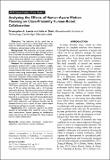| dc.contributor.author | Lasota, Przemyslaw Andrzej | |
| dc.contributor.author | Shah, Julie A. | |
| dc.date.accessioned | 2015-06-26T13:26:08Z | |
| dc.date.available | 2015-06-26T13:26:08Z | |
| dc.date.issued | 2015-01 | |
| dc.date.submitted | 2014-06 | |
| dc.identifier.issn | 0018-7208 | |
| dc.identifier.issn | 1547-8181 | |
| dc.identifier.uri | http://hdl.handle.net/1721.1/97531 | |
| dc.description.abstract | Objective: The objective of this work was to examine human response to motion-level robot adaptation to determine its effect on team fluency, human satisfaction, and perceived safety and comfort.
Background: The evaluation of human response to adaptive robotic assistants has been limited, particularly in the realm of motion-level adaptation. The lack of true human-in-the-loop evaluation has made it impossible to determine whether such adaptation would lead to efficient and satisfying human–robot interaction.
Method: We conducted an experiment in which participants worked with a robot to perform a collaborative task. Participants worked with an adaptive robot incorporating human-aware motion planning and with a baseline robot using shortest-path motions. Team fluency was evaluated through a set of quantitative metrics, and human satisfaction and perceived safety and comfort were evaluated through questionnaires.
Results: When working with the adaptive robot, participants completed the task 5.57% faster, with 19.9% more concurrent motion, 2.96% less human idle time, 17.3% less robot idle time, and a 15.1% greater separation distance. Questionnaire responses indicated that participants felt safer and more comfortable when working with an adaptive robot and were more satisfied with it as a teammate than with the standard robot.
Conclusion: People respond well to motion-level robot adaptation, and significant benefits can be achieved from its use in terms of both human–robot team fluency and human worker satisfaction.
Application: Our conclusion supports the development of technologies that could be used to implement human-aware motion planning in collaborative robots and the use of this technique for close-proximity human–robot collaboration. | en_US |
| dc.language.iso | en_US | |
| dc.publisher | Sage Publications | en_US |
| dc.relation.isversionof | http://dx.doi.org/10.1177/0018720814565188 | en_US |
| dc.rights | Creative Commons Attribution | en_US |
| dc.rights.uri | http://creativecommons.org/licenses/by-nc/3.0/ | en_US |
| dc.source | Sage Publications | en_US |
| dc.title | Analyzing the Effects of Human-Aware Motion Planning on Close-Proximity Human-Robot Collaboration | en_US |
| dc.type | Article | en_US |
| dc.identifier.citation | Lasota, P. A., and J. A. Shah. “Analyzing the Effects of Human-Aware Motion Planning on Close-Proximity Human-Robot Collaboration.” Human Factors: The Journal of the Human Factors and Ergonomics Society 57, no. 1 (January 21, 2015): 21–33. © 2015 Human Factors and Ergonomics Society | en_US |
| dc.contributor.department | Massachusetts Institute of Technology. Department of Aeronautics and Astronautics | en_US |
| dc.contributor.mitauthor | Lasota, Przemyslaw Andrzej | en_US |
| dc.contributor.mitauthor | Shah, Julie A. | en_US |
| dc.relation.journal | Human Factors: The Journal of the Human Factors and Ergonomics Society | en_US |
| dc.eprint.version | Final published version | en_US |
| dc.type.uri | http://purl.org/eprint/type/JournalArticle | en_US |
| eprint.status | http://purl.org/eprint/status/PeerReviewed | en_US |
| dspace.orderedauthors | Lasota, P. A.; Shah, J. A. | en_US |
| dc.identifier.orcid | https://orcid.org/0000-0002-1761-221X | |
| dc.identifier.orcid | https://orcid.org/0000-0003-1338-8107 | |
| mit.license | PUBLISHER_CC | en_US |
| mit.metadata.status | Complete | |
